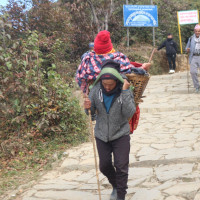- Sunday, 2 November 2025
Elephant Conservation
Over the past decades, Nepal has made illustrious achievements in wildlife conservation. This has earned the country global fame as a frontrunner in these laudable efforts. However, as the number of wildlife grows, so do the risks of animal-human conflict. With shrinking habitat, caused by deforestation, wildfire and encroachment of the forest, the conflict continues to be a significant issue. Animals kill and injure people, and damage crops and property. Animals are also poached in this tussle.
However, both suffer from the conflict. Given this precarious balance between humans and animals, Nepal has made systemic efforts at wildlife conservation, creating an environment where humans and animals coexist without harming each other. As part of this mission, it has brought an Elephant Conservation Action Plan 2025-2035 that aims to protect the wild elephant population and align conservation needs with development priorities.
The community should support various targets set by the action plan to mitigate human-elephant conflict. Conservation efforts need the active participation of the community to get fruitful results. Conserving critical corridors for the free movement of elephants is very important. Likewise, there is a need to control poaching and illegal wildlife trade. Conserving and expanding habitats is important for the conservation of elephants.
Elephants are important in the ecosystem, as they play a key role in the dispersal of seeds and creating water holes. According to a news report published in this daily, 23 elephants have died in the past 15 years due to human intervention. Likewise, in the past 23 years, at least 350 people have been killed by elephants. Much of the elephant habitat lies outside the protected areas. Conservation officers have warned that the situation of wild elephants is dire as a result of the main breeding males being targeted and killed. If things continue like this and no intervention measures are taken, no wild elephants will be left in the next 50 years.
Destruction of habitat leads elephants to venture into human settlements in search of food, inviting human-wildlife conflict. Likewise, there is a need for a dedicated corridor for elephants to roam freely, which could also significantly reduce human-wildlife conflict. We frequently come across news of elephants being killed due to electrocution or other causes, and wild elephants causing havoc in the settlements, especially in Jhapa and Morang.
In the past, tuberculosis (TB) in elephants, both captive and wild, was a huge challenge for conservationists. In the past four years, no sign of TB has been observed in elephants in Chitwan, which indicates that treatment has been effective. Elephants are also susceptible to various infectious diseases like rabies, tetanus, and anthrax, so the government should continue screening, testing and medication for elephants to make sure that TB among elephants is eradicated. Likewise, enhancing research and monitoring, tackling poaching and illegal trade and strengthening partnerships at the local, national, and international levels are crucial for conserving elephants.
Although Nepal has achieved remarkable success in increasing the elephant population, habitat management and reducing human-animal conflict have to be the priority of the government and the national parks. As a large number of foreigners visit the country to relish in its thriving wildlife, the strategy to reduce human-animal conflict bears significance. The authorities need to muster the cooperation of the locals to effectively translate the strategy into action.







-square-thumb.jpg)

-original-thumb.jpg)







